Structure of an In Situ Phosphorus-Doped Silicon Ultrathin Film Analyzed Using Second Harmonic Generation and Simplified Bond-Hyperpolarizability Model
Abstract
1. Introduction
2. Theory
2.1. SBHM
2.2. Bulk Quadrupolar SHG from Si(100)
Si Lattice Affected by Doping
2.3. Interfacial Dipolar SHG from Si(100)
2.4. Dipolar SHG from the Dopant Site
3. Materials and Methods
3.1. Measurement of Ani-RSHG Spectrum
3.2. Process of Data-Fitting Based on the SBHM
4. Results and Discussion
4.1. Effect of Thickness and Calibration
4.2. Correlation to Fourier Analysis
5. Conclusions
Author Contributions
Funding
Data Availability Statement
Conflicts of Interest
References
- Dennard, R.H.; Gaensslen, F.H.; Yu, H.-N.; Rideout, V.L.; Bassous, E.; LeBlanc, A.R. Design of ion-implanted MOSFET’s with very small physical dimensions. IEEE J. Solid State Circuits 1974, 9, 256–268. [Google Scholar] [CrossRef]
- Breton, M.A.; Schmidt, D.; Greene, A.; Frougier, J.; Felix, N. Review of nanosheet metrology opportunities for technology readiness. J. Micro Nanopattern. Mater. Metrol. 2022, 21, 021206. [Google Scholar] [CrossRef]
- Chamness, L. Dawn of the Data-Centric Era. Available online: https://semiengineering.com/dawn-of-the-data-centric-era/ (accessed on 30 December 2018).
- Radamson, H.H.; Zhu, H.; Wu, Z.; He, X.; Lin, H.; Liu, J.; Xiang, J.; Kong, Z.; Xiong, W.; Li, J.; et al. State of the Art and Future Perspectives in Advanced CMOS Technology. Nanomaterials 2020, 10, 1555. [Google Scholar] [CrossRef] [PubMed]
- Lee, K.-S.; Park, J.-Y. N-Type Nanosheet FETs without Ground Plane Region for Process Simplification. Micromachines 2022, 13, 432. [Google Scholar] [CrossRef] [PubMed]
- Loubet, N.; Hook, T.; Montanini, P.; Yeung, C.-W.; Kanakasabapathy, S.; Guillom, M.; Yamashita, T.; Zhang, J.; Miao, X.; Wang, J.; et al. Stacked nanosheet gate-all-around transistor to enable scaling beyond FinFET. In Proceedings of the IEEE 2017 Symposium on VLSI Technology, Las Vegas, NV, USA, 9–12 April 2017; pp. T230–T231. [Google Scholar] [CrossRef]
- Chason, E.; Picraux, S.T.; Poate, J.M.; Borland, J.O.; Current, M.I.; Diaz de la Rubia, T.; Eaglesham, D.J.; Holland, O.W.; Law, M.E.; Magee, C.W.; et al. Ion beams in silicon processing and characterization. J. Appl. Phys. 1997, 81, 6513–6561. [Google Scholar] [CrossRef]
- Lee, J.; Ko, E.; Shin, H.; Ko, D. Defect Generation Mechanism of Epitaxially Grown In Situ Phosphorus-Doped Silicon on Silicon (111) Substrate. Phys. Status Solidi 2020, 217, 1900990. [Google Scholar] [CrossRef]
- Weeks, K.D.; Thomas, S.G.; Dholabhai, P.; Adams, J. Characterization and analysis of epitaxial silicon phosphorus alloys for use in n-channel transistors. Thin Solid Films 2012, 520, 3158–3162. [Google Scholar] [CrossRef]
- Trumbore, F.A. Solid Solubilities of Impurity Elements in Germanium and Silicon. Bell Syst. Tech. J. 1960, 39, 205–233. [Google Scholar] [CrossRef]
- Mostafa, A.; Medraj, M. Binary Phase Diagrams and Thermodynamic Properties of Silicon and Essential Doping Elements (Al, As, B, Bi, Ga, In, N, P, Sb and Tl). Materials 2017, 10, 676. [Google Scholar] [CrossRef]
- Lee, M.; Ryu, H.Y.; Ko, E.; Ko, D.H. Effects of Phosphorus Doping and Postgrowth Laser Annealing on the Structural, Electrical, and Chemical Properties of Phosphorus-Doped Silicon Films. ACS Appl. Electron. Mater. 2019, 1, 288–301. [Google Scholar] [CrossRef]
- Tsai, C.H.; Hsu, Y.H.; Santos, I.; Pelaz, L.; Kowalski, J.E.; Liou, J.W.; Woon, W.Y.; Lee, C.K. Achieving junction stability in heavily doped epitaxial Si:P. Mater. Sci. Semicond. Process. 2021, 127, 105672. [Google Scholar] [CrossRef]
- Tsai, C.-H.; Savant, C.P.; Asadi, M.J.; Lin, Y.-M.; Santos, I.; Hsu, Y.-H.; Kowalski, J.; Pelaz, L.; Woon, W.-Y.; Lee, C.-K.; et al. Efficient and stable activation by microwave annealing of nanosheet silicon doped with phosphorus above its solubility limit. Appl. Phys. Lett. 2022, 121, 052103. [Google Scholar] [CrossRef]
- Peng, H.J.; Adles, E.J.; Wang, J.-F.T.; Aspnes, D.E. Relative bulk and interface contributions to optical second-harmonic generation in silicon. Phys. Rev. B 2005, 72, 205203. [Google Scholar] [CrossRef]
- Ogata, Y. Optical second harmonic generation from nanostructure-covered micro-cubes on nickel. Opt. Mater. Express 2016, 6, 1520. [Google Scholar] [CrossRef]
- Powell, G.D.; Wang, J.-F.; Aspnes, D.E. Simplified bond-hyperpolarizability model of second harmonic generation. Phys. Rev. B 2002, 65, 205320. [Google Scholar] [CrossRef]
- Lo, K.Y. Study on the rapid thermal annealing process of low-energy arsenic and phosphorous ion-implanted silicon by reflective second harmonic generation. J. Phys. D Appl. Phys. 2005, 38, 3926–3933. [Google Scholar] [CrossRef]
- Lo, K.Y.; Huang, Y.J. Annealing influences on phosphorus-ion-implanted vicinal Si(111) studied by reflective second-harmonic generation. Phys. Rev. B 2007, 76, 035302. [Google Scholar] [CrossRef]
- Liu, C.-C.; Liu, C.-W.; Cheng, J.-Y.; Huang, Y.-J.; Lo, K.-Y. Structural evolution of implanted vicinal Si(111) during annealing via analysis of the dipole contribution. J. Appl. Phys. 2011, 110, 103520. [Google Scholar] [CrossRef]
- Liu, C.-W.; Chang, S.-J.; Liu, C.-C.; Lo, K.-Y. Inspecting the surface of implanted Si(111) during annealing by reflective second harmonic generation: The influence of chamber pressure. Thin Solid Films 2013, 529, 282–286. [Google Scholar] [CrossRef]
- Malard, L.M.; Alencar, T.V.; Barboza, A.P.M.; Mak, K.F.; de Paula, A.M. Observation of intense second harmonic generation from MoS2 atomic crystals. Phys. Rev. B 2013, 87, 201401. [Google Scholar] [CrossRef]
- Psilodimitrakopoulos, S.; Mouchliadis, L.; Paradisanos, I.; Lemonis, A.; Kioseoglou, G.; Stratakis, E. Ultrahigh-resolution nonlinear optical imaging of the armchair orientation in 2D transition metal dichalcogenides. Light Sci. Appl. 2018, 7, 18005. [Google Scholar] [CrossRef] [PubMed]
- Reitböck, C.; Stifter, D.; Alejo-Molina, A.; Hardhienata, H.; Hingerl, K. Nonlinear ellipsometry of Si(111) by second harmonic generation. Appl. Surf. Sci. 2017, 421, 761–765. [Google Scholar] [CrossRef]
- Reitböck, C.; Stifter, D.; Alejo-Molina, A.; Hingerl, K.; Hardhienata, H. Bulk quadrupole and interface dipole contribution for second harmonic generation in Si(111). J. Opt. 2016, 18, 035501. [Google Scholar] [CrossRef]
- Zhang, X.; Chen, Z.; Xuan, L.; Pan, S.; Yang, G. Enhancement of bulklike second-order nonlinear susceptibility in SiGe/Si step wells and biasing-field controlled (SiGe)100 superlattices. Phys. Rev. B 1997, 56, 15842–15846. [Google Scholar] [CrossRef]
- Zhao, J.-H.; Cheng, B.-W.; Chen, Q.-D.; Su, W.; Jiang, Y.; Chen, Z.-G.; Jia, G.; Sun, H.-B. Near-Infrared Femtosecond Laser for Studying the Strain in Si1-xGex Alloy Films via Second-Harmonic Generation. IEEE Photon. J. 2010, 2, 974–980. [Google Scholar] [CrossRef]
- Scheidt, T.; Rohwer, E.G.; Von Bergmann, H.M.; Stafast, H. Charge-carrier dynamics and trap generation in native Si/SiO2 interfaces probed by optical second-harmonic generation. Phys. Rev. B Condens. Matter Mater. Phys. 2004, 69, 165314. [Google Scholar] [CrossRef]
- Mihaychuk, J.G.; Shamir, N.; van Driel, H.M. Multiphoton photoemission and electric-field-induced optical second-harmonic generation as probes of charge transfer across the Si/SiO2 interface. Phys. Rev. B 1999, 59, 2164–2173. [Google Scholar] [CrossRef]
- Hardhienata, H.; Alejo-Molina, A.; Reitböck, C.; Prylepa, A.; Stifter, D.; Hingerl, K. Bulk dipolar contribution to second-harmonic generation in zincblende. J. Opt. Soc. Am. B 2016, 33, 195. [Google Scholar] [CrossRef]
- Bloembergen, N.; Chang, R.K.; Jha, S.S.; Lee, C.H. Optical Second-Harmonic Generation in Reflection from Media with Inversion Symmetry. Phys. Rev. 1968, 174, 813–822. [Google Scholar] [CrossRef]
- Hardhienata, H.; Prylepa, A.; Stifter, D.; Hingerl, K. Simplified bond-hyperpolarizability model of second-harmonic-generation in Si(111): Theory and experiment. J. Phys. Conf. Ser. 2013, 423, 012046. [Google Scholar] [CrossRef]
- Kwon, J.; Downer, M.C.; Mendoza, B.S. Second-harmonic and reflectance-anisotropy spectroscopy of vicinal Si(001)/SiO2 interfaces: Experiment and simplified microscopic model. Phys. Rev. B 2006, 73, 195330. [Google Scholar] [CrossRef]
- Wang, J.-F.T.; Powell, G.D.; Johnson, R.S.; Lucovsky, G.; Aspnes, D.E. Simplified bond-hyperpolarizability model of second harmonic generation: Application to Si-dielectric interfaces. J. Vac. Sci. Technol. B Microelectron. Nanom. Struct. 2002, 20, 1699. [Google Scholar] [CrossRef]
- Yang, S.A.; Li, X.; Bristow, A.D.; Sipe, J.E. Second harmonic generation from tetragonal centrosymmetric crystals. Phys. Rev. B 2009, 80, 165306. [Google Scholar] [CrossRef]
- Li, X.; Dube, A.; Ye, Z.; Sharma, S.; Kim, Y.; Chu, S. Selective Epitaxial Si:P Film for nMOSFET Application: High Phosphorous Concentration and High Tensile Strain. ECS Trans. 2014, 64, 959–965. [Google Scholar] [CrossRef]
- Sipe, J.; Moss, D.; vanDriel, H. Phenomenological theory of optical second- and third-harmonic generation from cubic centrosymmetric crystals. Phys. Rev. B 1987, 35, 1129–1141. [Google Scholar] [CrossRef]
- Hardhienata, H.; Priyadi, I.; Alatas, H.; Birowosuto, M.D.; Coquet, P. Bond model of second-harmonic generation in wurtzite ZnO(0002) structures with twin boundaries. J. Opt. Soc. Am. B 2019, 36, 1127. [Google Scholar] [CrossRef]
- Rosseel, E.; Dhayalan, S.K.; Hikavyy, A.Y.; Loo, R.; Profijt, H.B.; Kohen, D.; Kubicek, S.; Chiarella, T.; Yu, H.; Horiguchi, N.; et al. (Invited) Selective Epitaxial Growth of High-P Si:P for Source/Drain Formation in Advanced Si nFETs. ECS Meet. Abstr. 2016, MA2016-02, 2003. [Google Scholar] [CrossRef]
- Pearson, G.L.; Bardeen, J. Electrical Properties of Pure Silicon and Silicon Alloys Containing Boron and Phosphorus. Phys. Rev. 1949, 75, 865–883. [Google Scholar] [CrossRef]
- Celotti, G.; Nobili, D.; Ostoja, P. Lattice parameter study of silicon uniformly doped with boron and phosphorus. J. Mater. Sci. 1974, 9, 821–828. [Google Scholar] [CrossRef]
- Schinke, C.; Christian Peest, P.; Schmidt, J.; Brendel, R.; Bothe, K.; Vogt, M.R.; Kröger, I.; Winter, S.; Schirmacher, A.; Lim, S.; et al. Uncertainty analysis for the coefficient of band-to-band absorption of crystalline silicon. AIP Adv. 2015, 5, 067168. [Google Scholar] [CrossRef]
- Zhao, J.-H.; Li, C.-H.; Chen, Q.-D.; Cheng, B.-W.; Sun, H.-B. Surface Detection of Strain-Relaxed Si1−x Gex Alloys with High Ge-Content by Optical Second-Harmonic Generation. IEEE J. Quantum Electron. 2015, 51, 7000606. [Google Scholar] [CrossRef]
- Lüpke, G.; Bottomley, D.J.; van Driel, H.M. Second- and third-harmonic generation from cubic centrosymmetric crystals with vicinal faces: Phenomenological theory and experiment. J. Opt. Soc. Am. B 1994, 11, 33. [Google Scholar] [CrossRef]
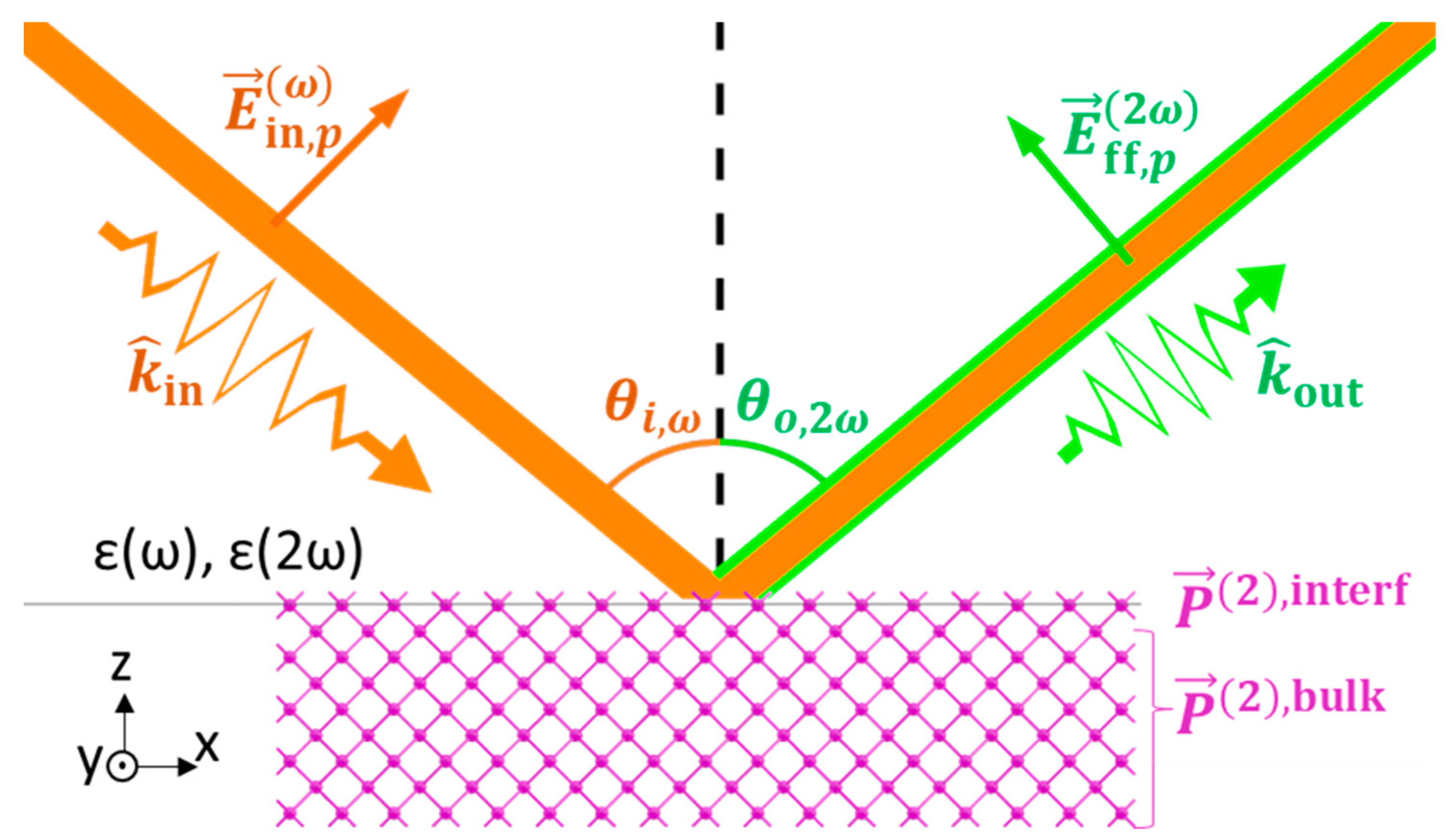
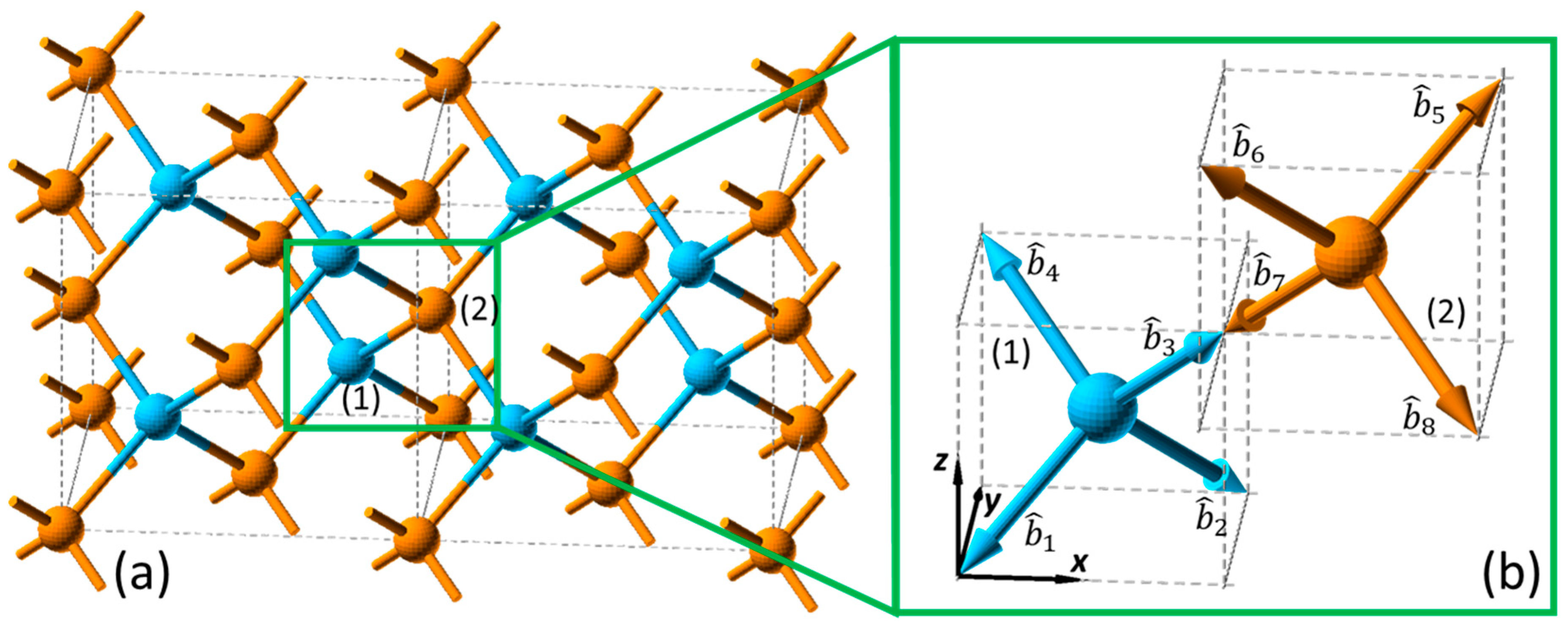
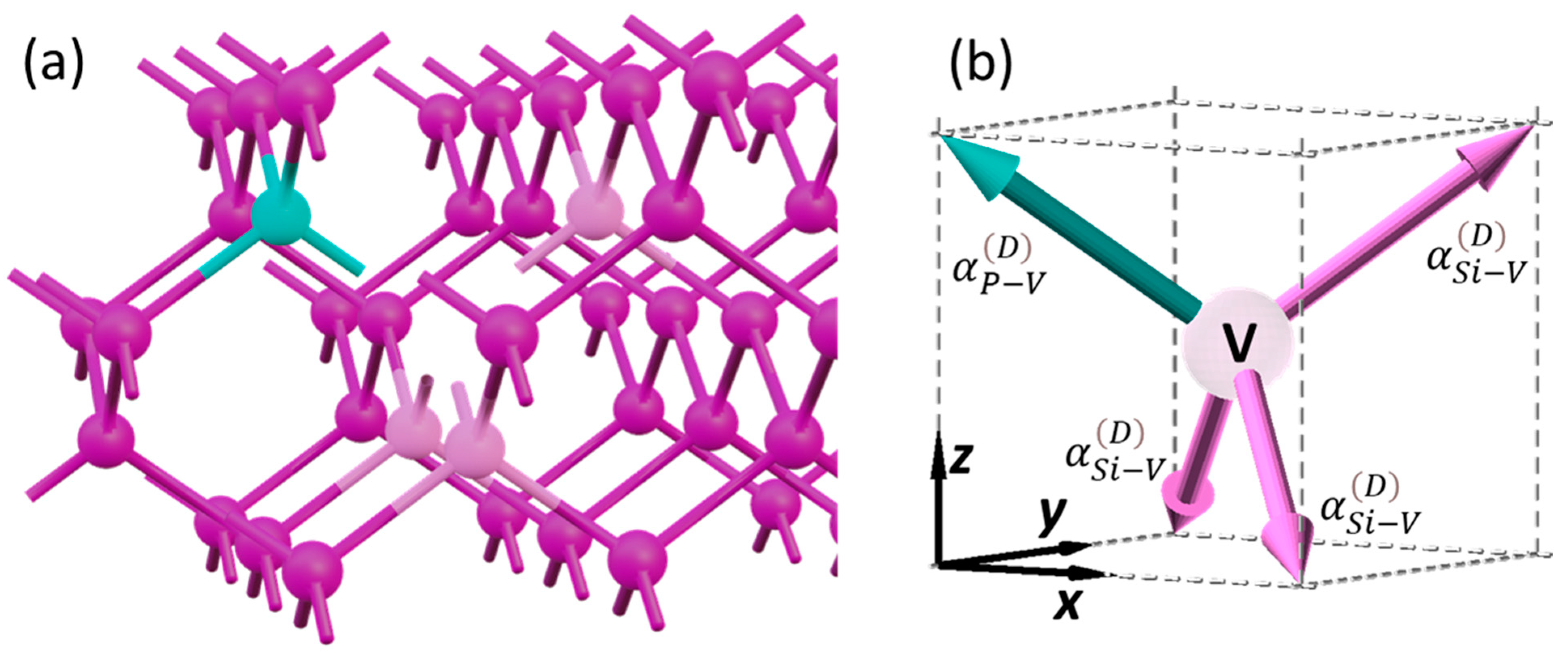

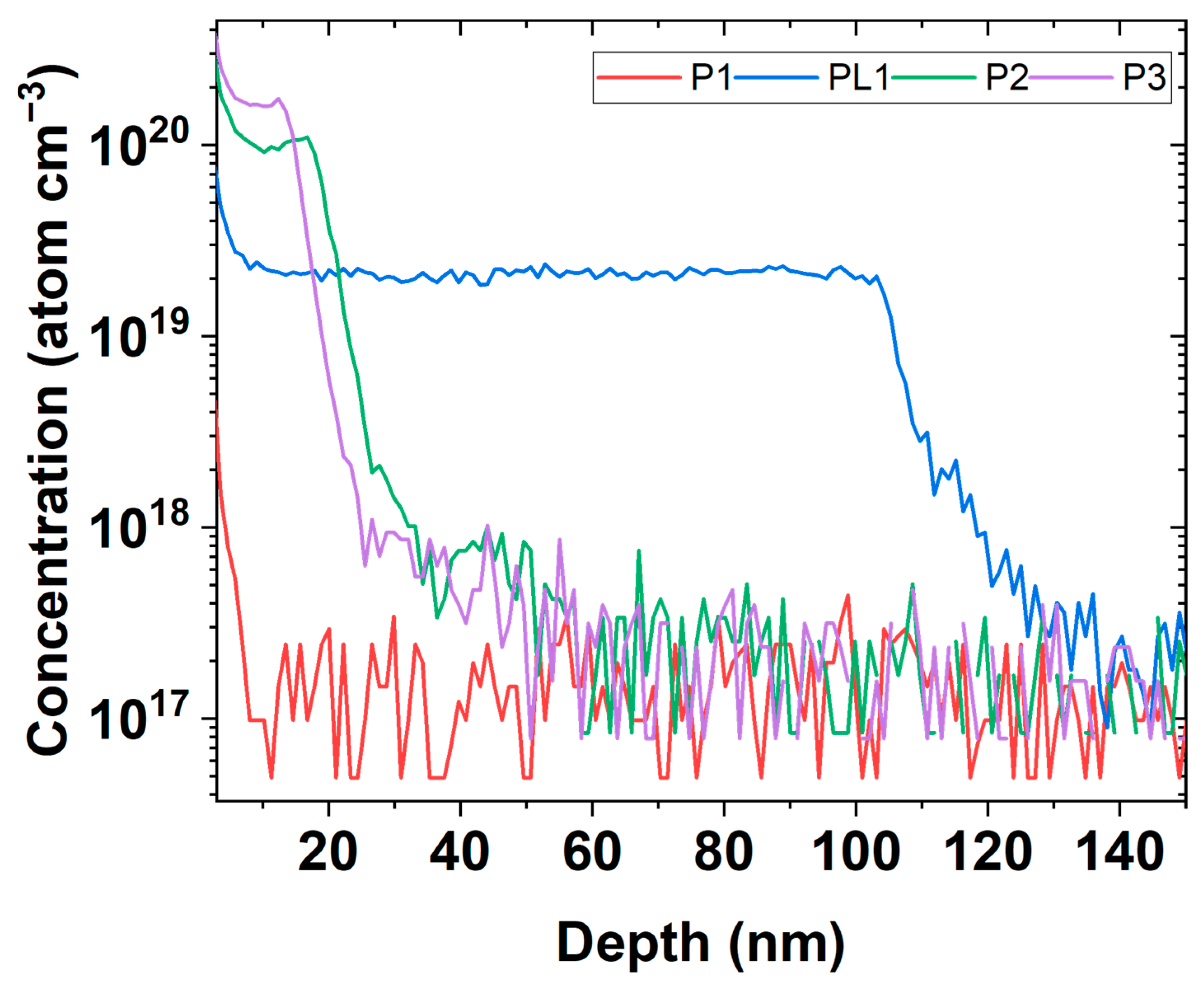
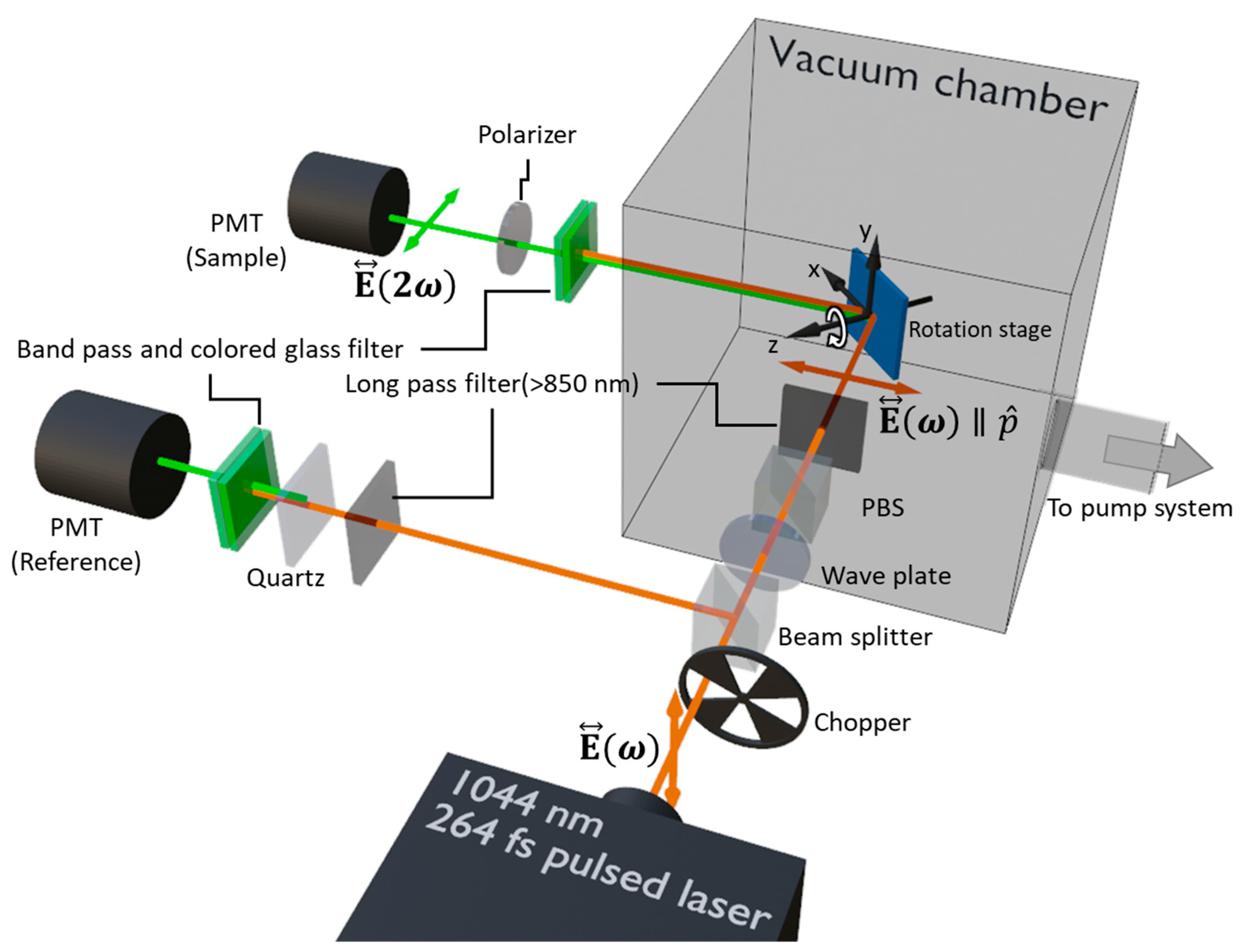
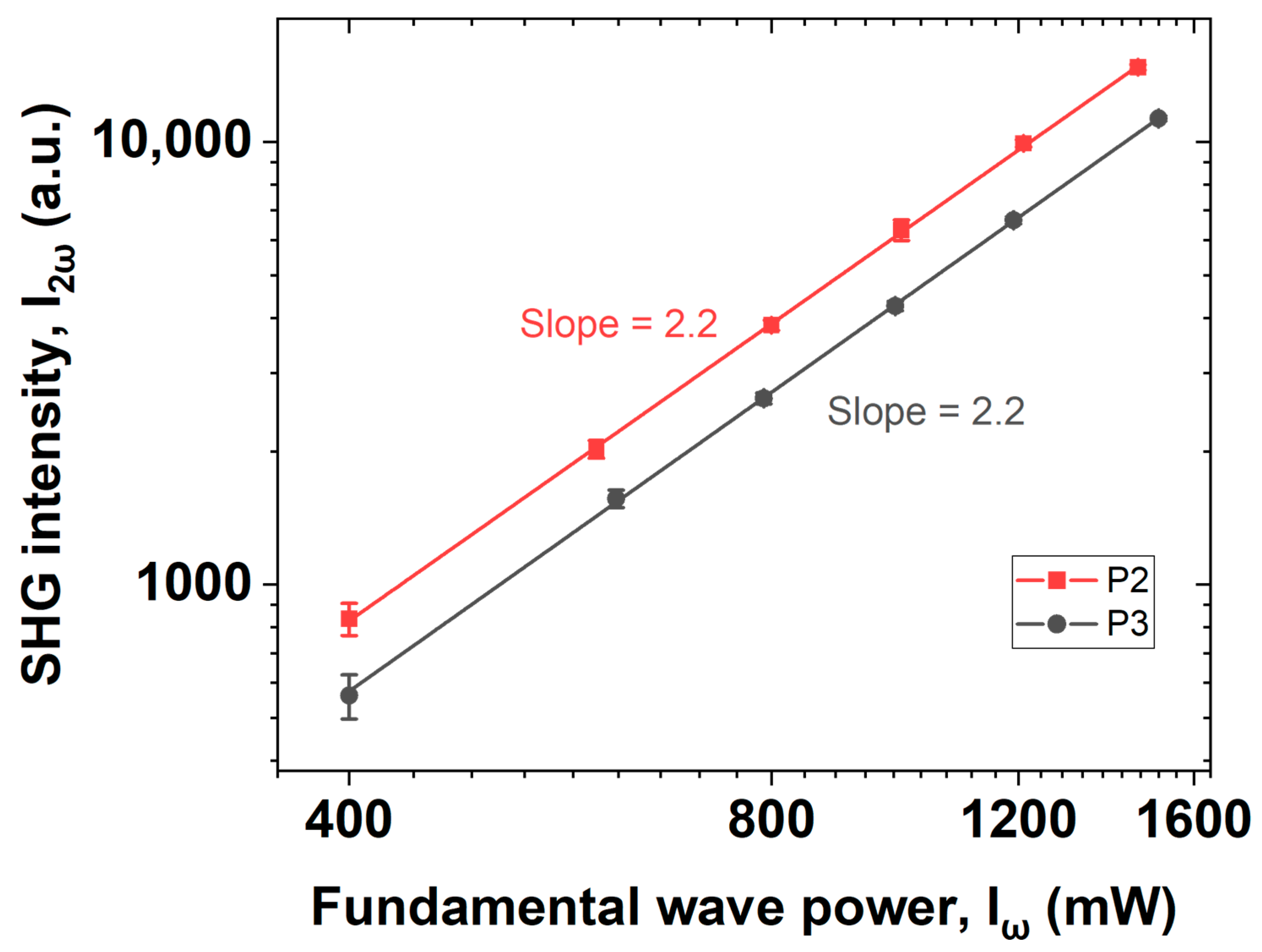
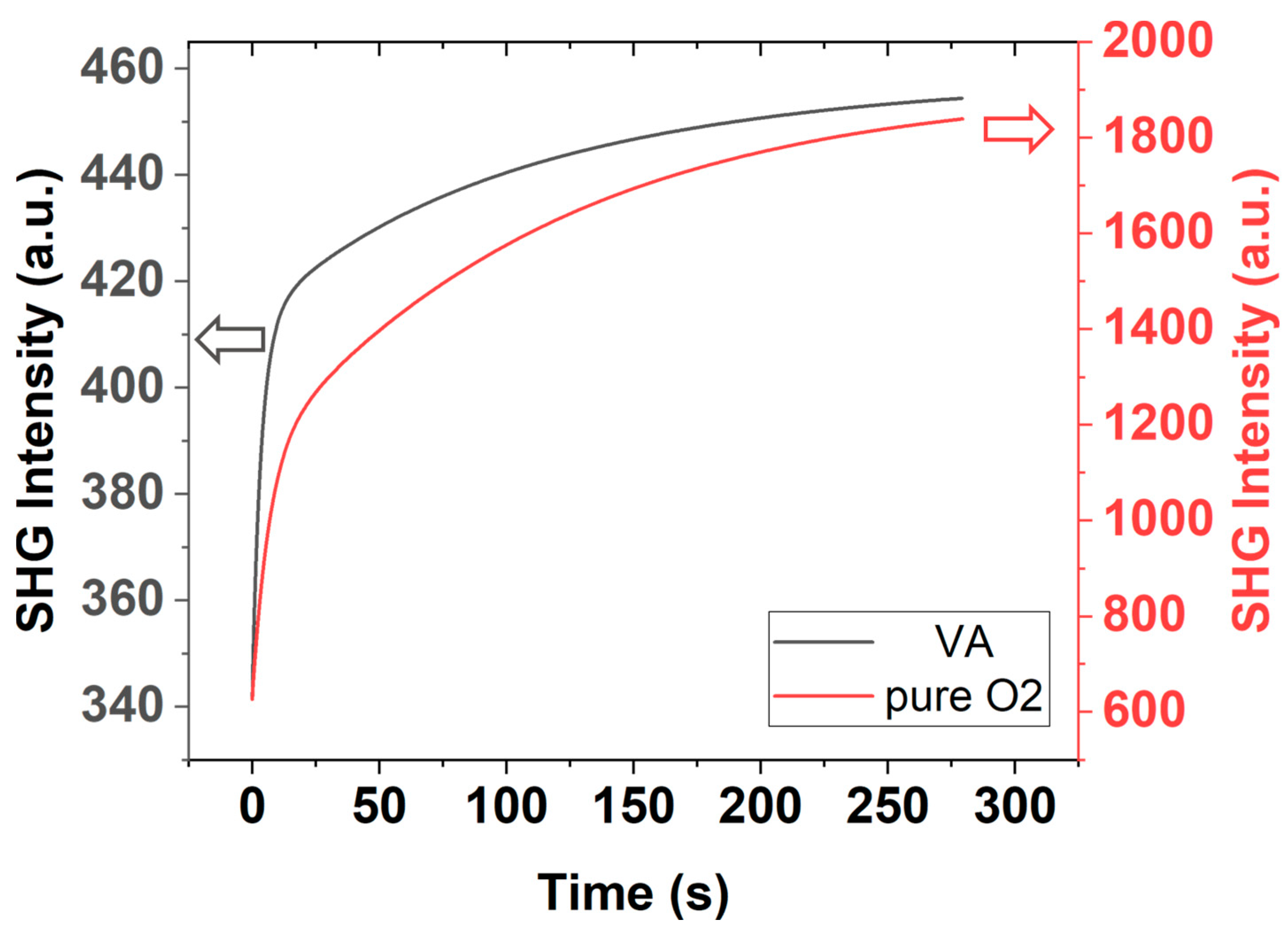
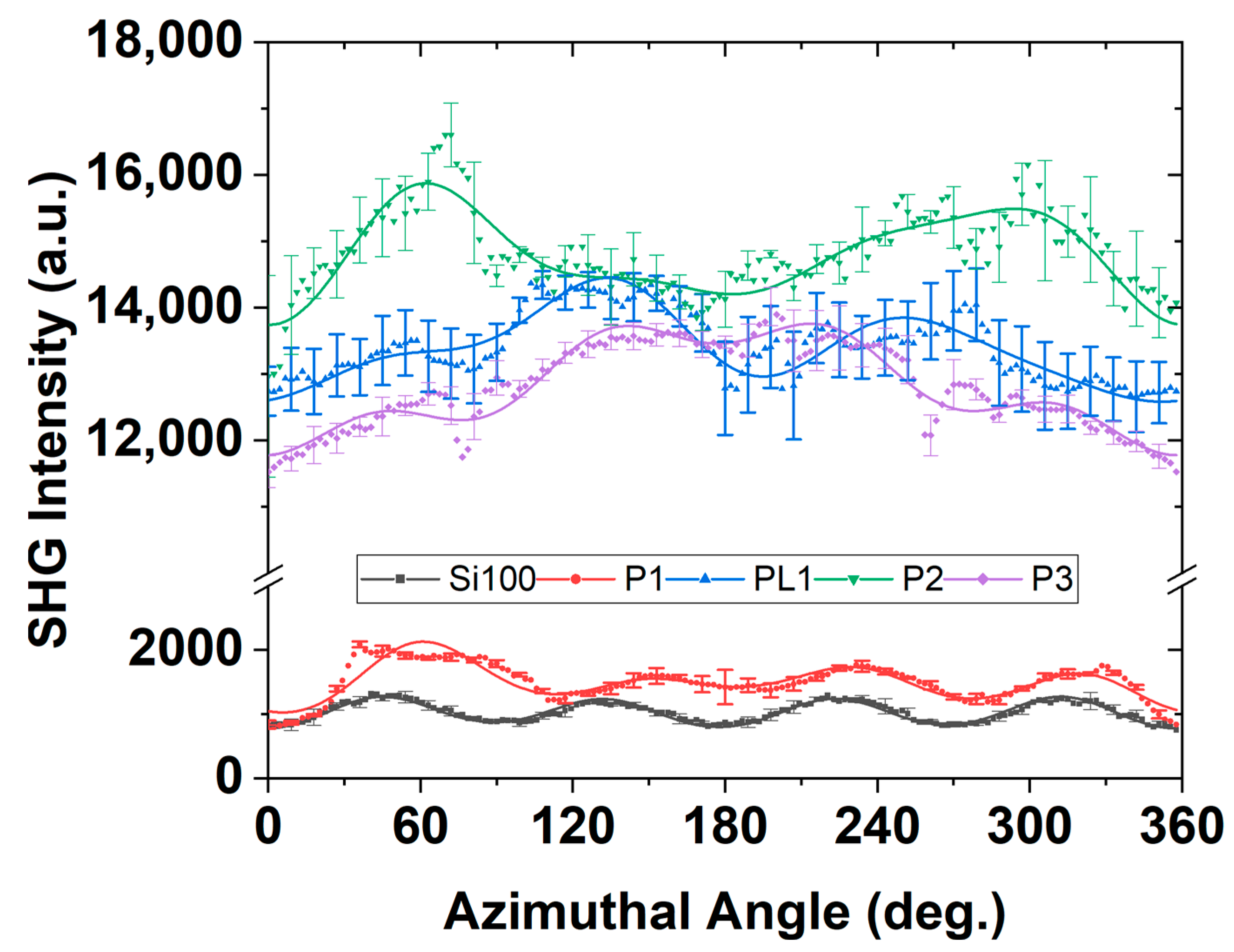
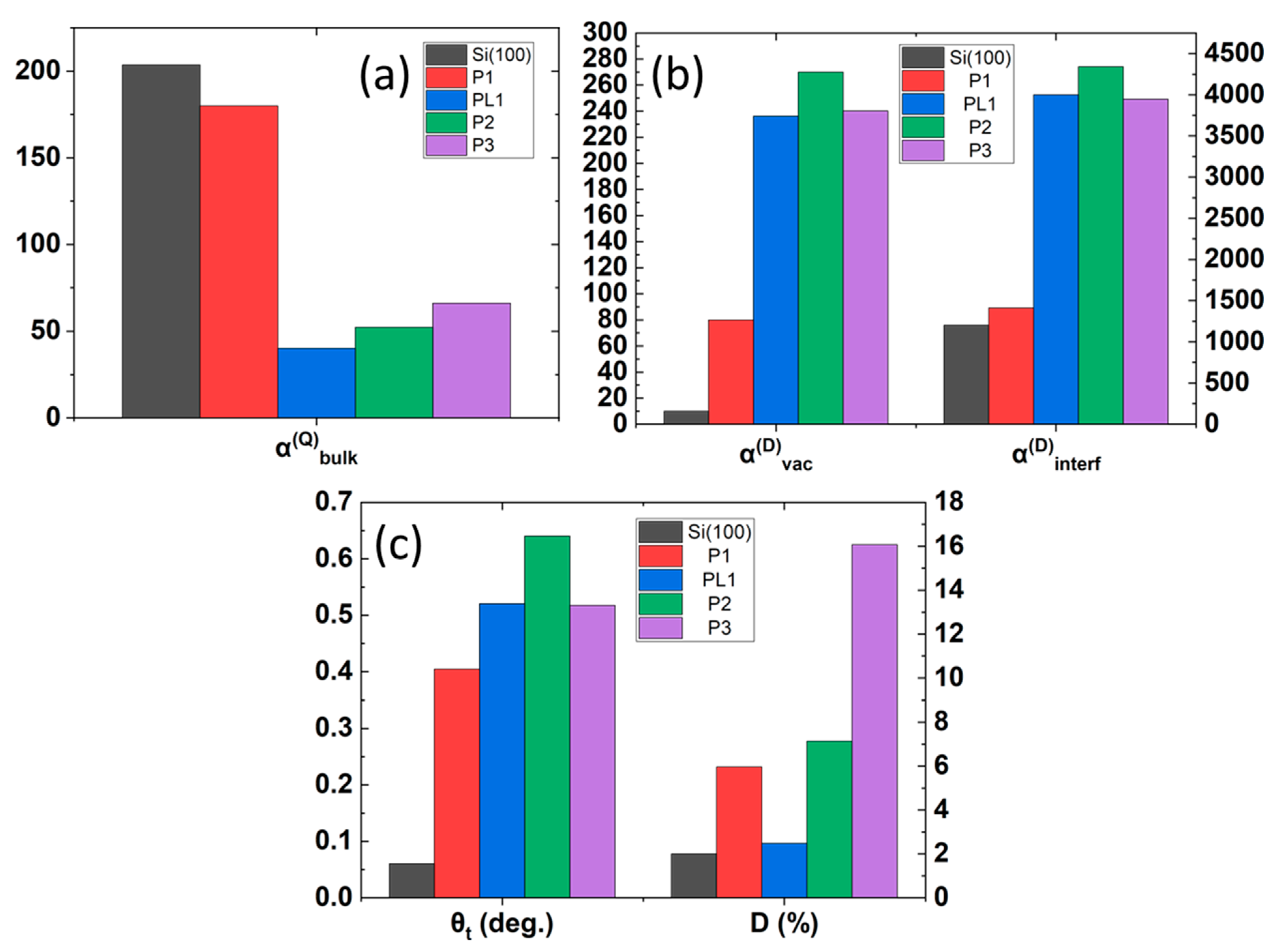
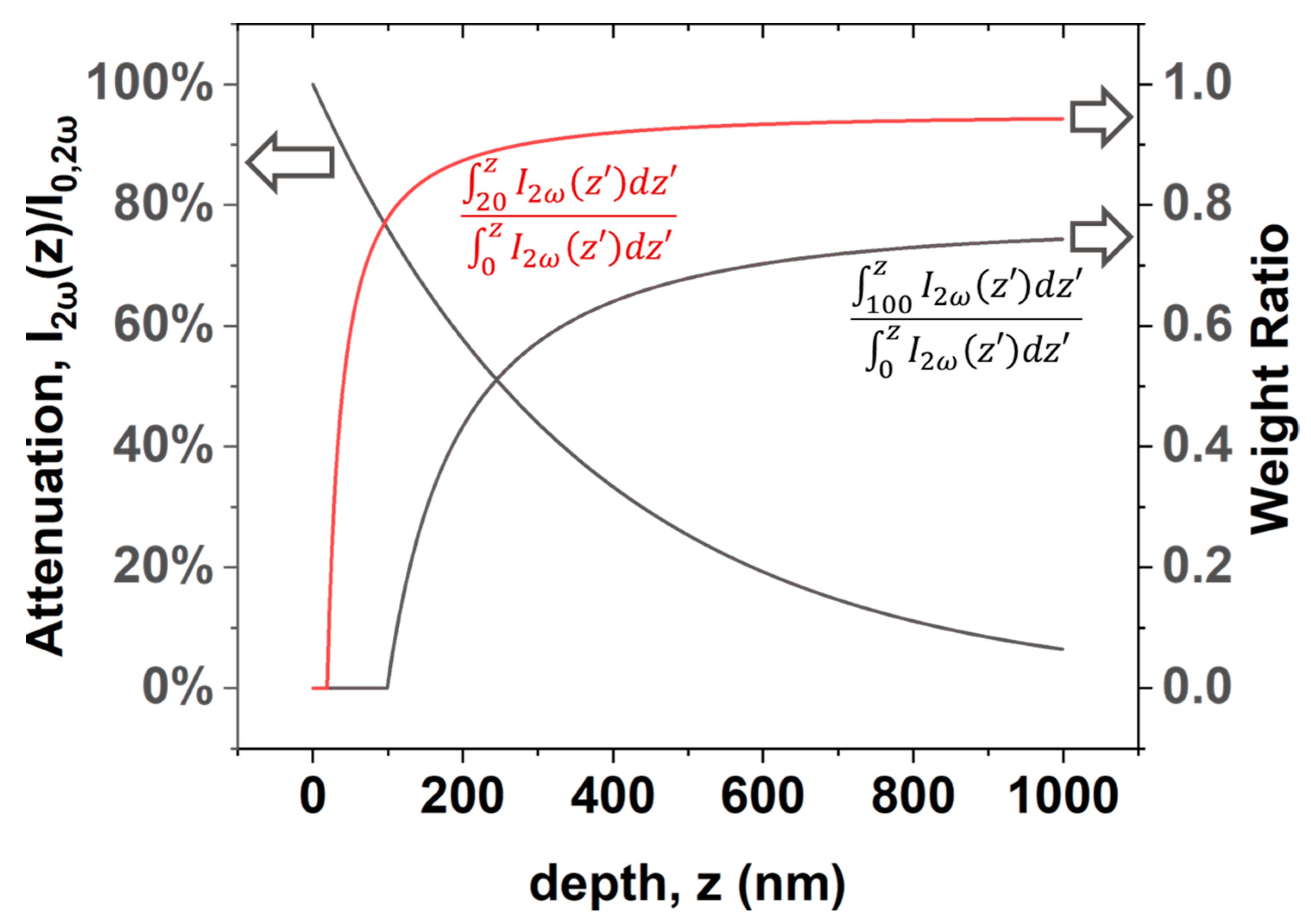
Publisher’s Note: MDPI stays neutral with regard to jurisdictional claims in published maps and institutional affiliations. |
© 2022 by the authors. Licensee MDPI, Basel, Switzerland. This article is an open access article distributed under the terms and conditions of the Creative Commons Attribution (CC BY) license (https://creativecommons.org/licenses/by/4.0/).
Share and Cite
Chen, W.-T.; Yen, T.-Y.; Hung, Y.-H.; Lo, K.-Y. Structure of an In Situ Phosphorus-Doped Silicon Ultrathin Film Analyzed Using Second Harmonic Generation and Simplified Bond-Hyperpolarizability Model. Nanomaterials 2022, 12, 4307. https://doi.org/10.3390/nano12234307
Chen W-T, Yen T-Y, Hung Y-H, Lo K-Y. Structure of an In Situ Phosphorus-Doped Silicon Ultrathin Film Analyzed Using Second Harmonic Generation and Simplified Bond-Hyperpolarizability Model. Nanomaterials. 2022; 12(23):4307. https://doi.org/10.3390/nano12234307
Chicago/Turabian StyleChen, Wei-Ting, Ting-Yu Yen, Yang-Hao Hung, and Kuang-Yao Lo. 2022. "Structure of an In Situ Phosphorus-Doped Silicon Ultrathin Film Analyzed Using Second Harmonic Generation and Simplified Bond-Hyperpolarizability Model" Nanomaterials 12, no. 23: 4307. https://doi.org/10.3390/nano12234307
APA StyleChen, W.-T., Yen, T.-Y., Hung, Y.-H., & Lo, K.-Y. (2022). Structure of an In Situ Phosphorus-Doped Silicon Ultrathin Film Analyzed Using Second Harmonic Generation and Simplified Bond-Hyperpolarizability Model. Nanomaterials, 12(23), 4307. https://doi.org/10.3390/nano12234307






